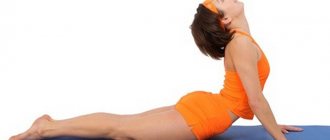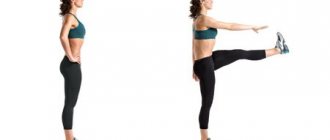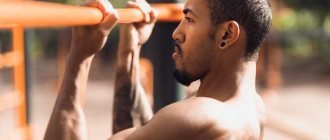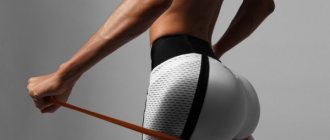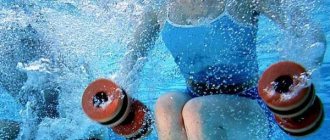A lot of both men and women do not mind increasing their body height. Many people do not know that it is quite possible to grow in height as an adult with the help of a number of exercises.
- How to increase your height as an adult?
- Video: Human anatomy - bone growth
- Exercises to increase body height
- What exercises should you do for your spine?
- "Cat"
- Video: Exercise “Cat”
- "Cobra"
- Video: Exercise “Cobra”
- Exercise "Boat"
- Video: Boat exercise for healthy posture
- Tilts
- Video: Bends, a set of exercises for stretching the spine
- Exercises on the horizontal bar
- Simple hang on the horizontal bar
- Video: Simple exercises for quickly stretching the spine
- Pull-ups on the horizontal bar
- Video: Pull-ups, correct technique
- Hanging Leg Raise
- Video: Raising legs to the bar
- Jumping
- Video: Jumping technique
- Tips and tricks to increase body height
How to increase your height as an adult?
A child grows in height due to bone growth. Growth continues until the special growth zones of the spine at the ends of the bones, which are called tubular, close. As long as these soft zones do not ossify, people can grow under the influence of growth hormone. On average, women's growth stops after 18 years, and men's - after 24.
Video: Human anatomy - bone growth
Adults will not be able to grow due to bone growth without surgery, but they can “stretch” themselves a little by doing sets of exercises to increase the space between the vertebrae and increase flexibility.
The spinal column consists of 24 vertebrae, the sacrum and the coccyx. Between the vertebrae there are intervertebral discs consisting of fibrocartilaginous tissue. They distribute and soften the load on the vertebrae and allow the back to bend. They are the ones that need to be stretched in order to increase the height of an adult.
1
Under the weight of a person’s own body and due to additional loads, the intervertebral discs compress over time. That's why most people get shorter as they age. Poor posture also affects the length of the spine. Having developed your height to your maximum (and this is usually 2–6 cm more than a person’s “established” height), you need to constantly maintain correct posture so as not to lose the gained centimeters.
Since there are only 23 intervertebral discs, and each can be stretched by a maximum of 3 mm, then a person can conditionally grow by a maximum of 6.9 cm.
Does strength training affect growth?
A topic that often excites people is the impact of hard training on growth. Here, as usual, there are several persistent myths, so it wouldn’t hurt to bring a little clarity to the question.
Human growth is programmed genetically, but the genetic program does not have a clear figure for what it will be. Roughly speaking, there is a range of 20–30 cm (sometimes more) into which a person’s height can fall, depending on environmental conditions. If everything goes well and conditions are favorable, then a person can reach the maximum of his “planned” growth, and if conditions are unfavorable, he can stop at the minimum.
What is included in the complex of genetic programs that determine growth? First of all, this is the activity of the endocrine glands, especially those that produce anabolic hormones, primarily growth hormone (somatotropin). GH can cause an increase in the size of many internal organs, but the growth zones in long bones and cartilage tissue are most sensitive to its action. A person’s growth zones close on average by the age of 25–27, and after that it becomes impossible to increase a person’s height (although plastic surgeons have learned to solve this problem).
If at the same time the amount of GH in the blood remains excessively high, then the person will grow cartilage tissue and internal organs, which is observed with pituitary gigantism, as well as in some bodybuilders with massive cheekbones, noses and ears, as well as huge protruding bellies despite distinct six-pack abs and minimal body fat.
What stimulates the production of GH? The main factors are physical activity (associated with the influence of lactic acid), hypoglycemia, i.e. a decrease in the amount of glucose in the blood (which, by the way, also happens during intense physical activity), sleep (one of the peaks of GH production is observed after 1.5– 2 hours after falling asleep), protein-rich meals.
The conditions primarily include the nature of nutrition. The improvement in the situation with the quantity and quality of food is one of the reasons for the increase in population growth in the last 100 years, and, for example, evolutionary psychologists explain the passion for long-legged ladies by the fact that preference is given to partners who ate well in childhood, which indirectly can serve as a sign of either higher social status, or a better ability to bear viable offspring.
In addition, factors such as sufficient insolation (affects the production of vitamin D), good living conditions (sufficient sleep is necessary), etc. play a role.
For example, why did young guys aged 18–20 years old in the army often reach 15–20 cm in height? Firstly, many of them began to eat normally and regularly for the first time. It cannot be said that there were many starving people in the Soviet Union, but even abundant food is not always synonymous with normal nutrition, not to mention the “bottle of kefir, half a loaf” situation.
Secondly, active physical activity, with an emphasis on horizontal bars and running - both the first and second at a certain level of intensity stimulate the production of lactic acid and hypoglycemia, which in total promotes the production of growth hormone, plus exercises on horizontal bars have a purely mechanical effect on growth zones in the bones , which helps create a point for hormone application.
Now to the question of how harmful strength loads in childhood and adolescence are in terms of their impact on growth. In fact, there are no clear studies on this topic; few people can afford to force children to carry weights in order to see what comes of it, although there are precedents when parents did this and, by the way, without any problems. Common sense suggests that children and young people have not yet developed skeletal, muscular and cardiovascular systems, the nervous system does not work well enough, the reaction to stress is more generalized, and all this does not speak in favor of strength training until the age of 15–16. . At this age, boys have a natural peak in testosterone synthesis, which can be easily judged by the specific area of acne per square centimeter of the face, and at this age it is already possible to engage in strength training and get excellent results from them.
However, it is advisable to focus on those exercises that do not provide large vertical loads - horizontal bars, parallel bars, and kettlebells will be the best choice at this age (from the standpoint of maintaining health). Girls should be more careful in choosing loads, they should give more preference to sports that focus on physical fitness and plasticity, and introduce strength training after the age of 18–20.
Well, the most important myth is that if you do strength training at an early age, you will not grow. It is based on combining two messages - that the law of universal gravitation was created so that we do not become two-meter basketball players, and if it is helped by a barbell, then even tall volleyball players will not be able to break through; and that most short weightlifters are plump men or young ladies, which means strength reduces their height. The first statement is very dubious, and the second confuses cause with effect.
The fact is that in professional sports it is not always the sport itself that makes a person look one way or another. A person with certain physical characteristics is taken into sports, and his strengths are also developed. Weightlifters often include short, stocky guys (endomorphs or hypersthenics according to the usual classification) due to the fact that they have some advantages in body leverage, allowing them to lift larger weights and have greater anabolic potential. And they become hypersthenics for the reason with which we started talking about growth - the balance of hormones.
Of course, this is a simplification, but the nature of the constitution depends on the balance of two types of anabolic hormones - the already mentioned growth hormone and sex anabolic steroids, such as testosterone. If the balance is in favor of GH (here we mean not only the level of secretion, but also the sensitivity of target tissues to hormones), then the person will be inclined to be tall and thin, and will be asthenic/ectomorphic; if the balance is towards anabolic steroids, then small, muscular and in the case of a man, probably bald, hypersthenic/endomorph; and between them there are many options for normosthenics, which may be closer in one direction or another.
In women, the balance of female sex hormones still needs to be added to the formula, and we will get many more types of constitution, depending on the nature of fat deposition in the body (O-, A, - I-, X, T - shaped body types). Of course, there are many other factors in this formula that accompany each type of constitution, such as the activity of the thyroid and adrenal glands (therefore, the temperament of different types of constitutions is quite predictably different), the rate of absorption of nutrients in the gastrointestinal tract and the activity of the endocrine glands (they in hypersthenics it is higher, which contributes to weight gain), etc., etc. But that’s another story.
Author: Oleg Tern
Exercises to increase body height
All sets of exercises aimed at growth, one way or another, stretch the spine. But spinal traction alone is not enough; you need strong core muscles to take the pressure off your back and support your new growth.
What you need to do to develop and maintain higher growth:
- stretch the spine with exercises;
- strengthen the torso muscles;
- maintain regularity.
What exercises should you do for your spine?
These are fairly simple exercises that will quickly develop strength and flexibility.
"Cat"
Even an unprepared beginner can master “Cat”:
- Get on all fours, placing your hands on the floor. The knees should be exactly under the pelvic bones, and the palms should be under the shoulders.
- As you exhale, round your back, arching it upward. Tilt your head down.
- As you inhale, bend in the other direction. Now the pelvis and head are directed upward.
- Do 10 reps.
1
Video: Exercise “Cat”
"Cobra"
Technique:
- Lie face down on the floor with your feet together.
- Place your palms under your shoulders. Elbows pressed to the body.
- As you inhale, slowly lift your upper body off the floor.
- The lift starts from the head, then the shoulders and chest.
- Do not straighten your elbows completely; your pelvis should remain on the floor.
- Hold the final pose for 10–15 seconds, maintaining calm breathing. Slowly return to the starting position.
- Perform the exercise 3-5 times.
1
It is quite possible that the first time you will not be able to raise the body very high. This is fine. The back will stretch gradually.
Video: Exercise “Cobra”
Exercise "Boat"
The “boat” perfectly stretches the body and uses many muscles. Therefore, before the exercise you need to actively warm up so that the muscles warm up.
Technique:
- Lie face down on the floor. Arms extended forward. The body forms a straight line.
- As you exhale, lift your left arm and right leg up.
- Even if the angle of elevation is small, maintain the position for 10–20 seconds.
- As you inhale, gently lower your limbs.
- Repeat for the other leg and arm.
- Repeat the exercise 2-3 times.
1
Video: Boat exercise for healthy posture
Tilts
Bends from a standing position will help stretch the spine due to the gravity of your own body.
Technique:
- Stand straight with your feet together.
- As you inhale, raise your arms and stretch up.
- As you exhale, bend over and try to touch your feet with your hands. If you have a good stretch, grab your shins and pull your chest toward your legs.
- Hold the bend for half a minute.
- Do the exercise 3 times.
- Over time, increase the number and depth of bends.
1
Video: Bends, a set of exercises for stretching the spine
Exercises on the horizontal bar
In training on the horizontal bar aimed at growth, it is important to alternate tension with relaxation, in this case the body has time to stretch under its own weight. Let's look at what exercises are the most effective.
Simple hang on the horizontal bar
Hanging from a bar helps your spine stretch, straighten, and relax. A simple hang should not cause pain or discomfort. If this happens, you need to ease the pressure on your back and arms and support your weight with your legs.
Hang from a bar or horizontal bar, holding onto it with an overhand or underhand grip. If you are a beginner, practice hanging for as long as possible. When you bring the time of continuous hanging to 30 seconds, you can start doing simple exercises:
- move your legs left and right, forward and backward while hanging on the horizontal bar;
- bend your knees, move them up and down;
- twist the body left and right;
- move both legs simultaneously in different directions.
Perform the exercises smoothly, without swaying while hanging.
1
Video: Simple exercises for quickly stretching the spine
Pull-ups on the horizontal bar
The difference from regular pull-ups is that you need to pause 5-10 seconds between repetitions. The pause should take place in a simple hang, during which you need to relax your back as much as possible.
Technique:
- Grasp the bar with your palms facing away from you - this is an overhand grip. Place your hands slightly wider than your shoulders.
- As you exhale, pull yourself up, trying to touch your chest to the bar.
- As you inhale, lower yourself to the starting position.
- Stay in a simple hang for 5-10 seconds, relax your back.
- Repeat the exercise 10–15 times.
If you don't yet know how to do pull-ups with your own weight, use a footrest.
If possible, perform the maximum number of repetitions in each approach, preferably at least 10. Do 3-4 sets.
1
Video: Pull-ups, correct technique
Hanging Leg Raise
If you are a trained athlete, you can add weights to better stretch your spine. But only if you have no medical contraindications.
Technique:
- Hang on the bar, holding onto it with any grip.
- As you exhale, raise your legs as high as possible. If your legs are bent, pull your knees towards your chest. If your legs are straight, aim to lift them towards the bar and hold in the final position.
- As you inhale, lower your legs to the starting position, remain in a simple hang for 5-10 seconds, let your back relax.
The higher you hang your legs, the better the spine will stretch.
1
Video: Raising legs to the bar
Jumping
To increase your height, you can jump in place, with a skipping rope, or play outdoor sports games, such as basketball. The best thing for the spine is jumping with the body stretched upward. You can increase your height in 1–2 months if you perform 200 jumps a day.
Technique:
- Place your feet shoulder-width apart.
- Bend your knees, tilt your pelvis back. Keep your back straight and your knees at an angle of no more than 45 degrees. The bent knee should not go forward behind the foot.
- As you exhale, jump up while raising your arms. At the end point the body should be a straight line.
- Return to the starting position, lower your arms.
When jumping in place, try to reach with your hand any object located high. This could be a lamp or a branch. Give all your best in the jump, stretch your whole body upward.
If you can't jump without a break, jump 10 times. Fill your breaks with other back stretching exercises.
Video: Jumping technique
Set of exercises 1
Starting position - asana Tiryaka Tadasana (“Bending Tree Pose”).
- Starting position (hereinafter referred to as IP) - standing, feet width apart, hands clasped at the top. Stand on your toes and stretch your whole body upward, then lower your hands, clasp them behind your back, stand on your heels, raise your toes. Repeat the exercise 10-12 times.
- (I.P.) - the same, arms to the sides, rotate them forward alternately at the wrist, elbow and shoulder joints. Repeat 10-12 times, lower your arms and relax. Repeat the exercise in the opposite direction.
- (I.P.) - standing, feet shoulder-width apart. Tilt your head to the right and left, try to touch your ear to your shoulder without lifting your shoulder. Repeat 10-12 times in each direction.
Berg technique - Utassana asana (forward bend)
- (I.P.) - legs spaced wider than shoulders. Bend forward, touching the floor with your fingers, repeat 20 times.
- Feet shoulder width apart. We bend back, trying to reach our heels with our fingers (20 times).
Berg's technique - asana Vrikshasana (“tree pose”)
- Bend your right leg at the knee and press your foot to the knee of your left leg. In this position, we lean forward, trying to touch the floor with our hands (20 times on each leg).
- Pull your arms back and grab the bar or the back of a chair at approximately the level of your shoulder blades. Sit down 20 times without letting go of the support.
- Place your feet together, bend forward 20 times, trying to touch your forehead to your knees.
- Sit on the floor, one leg extended forward, the other bent at the knee, foot pulled back. We lean forward, touching the floor with our hands.
- Lie on your back, legs extended, arms to the sides. We raise our legs one by one at right angles to the body.
Berg's technique - Asana Shalabhasana (“locust pose”)
- Turn over onto your stomach, legs straight, arms along your body. Raise your head, shoulders and legs from the floor without bending them, clasp your legs with your hands and stretch up.
- They knelt down and leaned on their hands, shoulder-width apart. They leaned forward, at the same time sitting on their heels, extended their arms, touched the floor, and lowered their heads.
Berg's method - asana Janu Shirshasana (“head to knee pose”)
- They sat on the floor, legs folded “Turkish style”, hands closed in front of the chest in a “lock”. We lift them up and stretch up as far as possible.
- Sitting on the floor, stretch your legs forward, bend forward, trying to reach your toes with your hands and your knees with your head.
- Lie on your back, hands on your lower back. We raise our legs up, trying to reach the floor behind our heads.
All exercises are repeated 15-20 times. 5-10 minutes of cardio is recommended before performing.
Tips and tricks to increase body height
To get the long-awaited result, follow these tips:
- Combine exercises, combine stretching, hanging and jumping.
- Exercise regularly. Stretching and jumping can be done daily.
- Once you have achieved the desired height, do not quit. Only strong back muscles can support growth.
- It will become easier for you to exercise if you leave your bad habits during training.
- Hanging on a horizontal bar is best performed by people who are not overweight. Otherwise, the spine will not relax, but will become more tense and will not be able to stretch. If you are overweight, use a leg support.
- In any activity, do not rush things. If the exercise doesn't work out, be patient. Excessive persistence can lead to injury.
- After the spinal stretching routine, give your back a rest. Don't lift anything heavy immediately after exercise.
- Swimming also promotes growth by stretching the spine. Add swimming sessions 2-3 times a week to your training, this will significantly improve your results.
Growing a few centimeters is a feasible task for every person. There are many ways to do this. You can choose one or perform all the exercises in combination. The main thing is regularity of training, and within a few weeks you will be able to see the first results.
